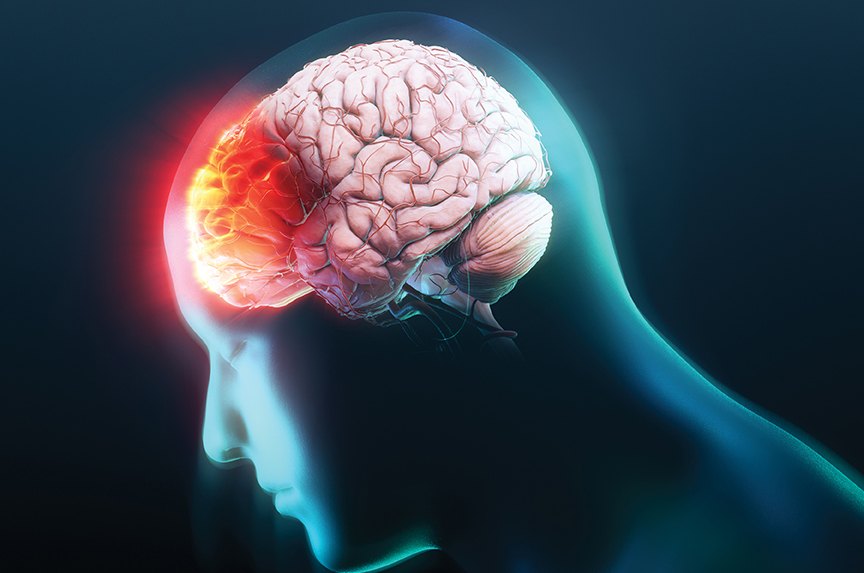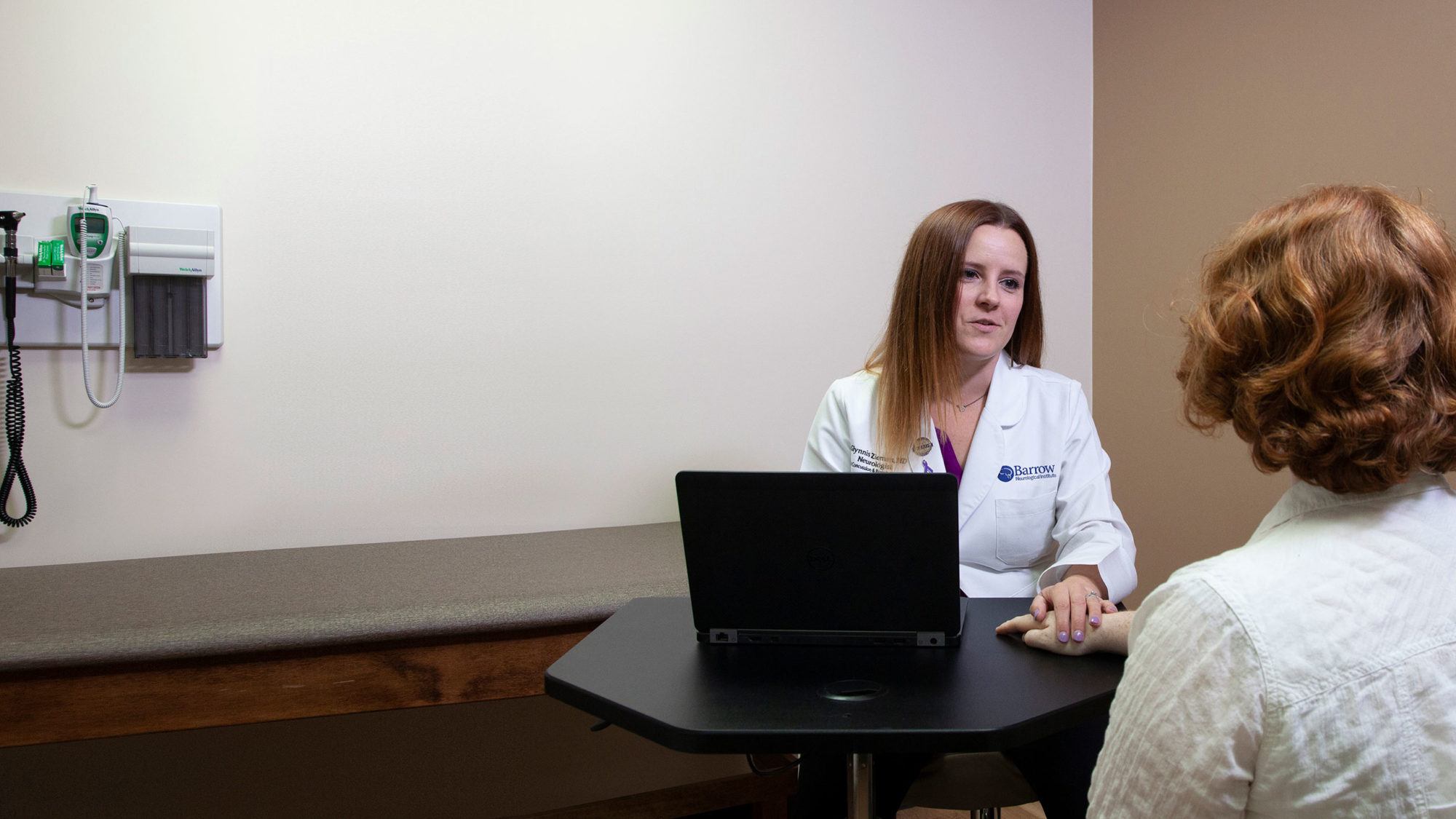
Concussion
Overview
A concussion is a type of traumatic brain injury (TBI) caused by rapid, forceful movement of the brain against the skull. This rapid movement triggers chemical and blood flow changes within the brain, causing brain tissue to change shape and temporarily alter its ability to function.

These sudden movements prompt symptoms like headache, nausea, vomiting, and problems with concentration, memory, and coordination. Although concussions are considered mild traumatic brain injuries, this does not mean that their symptoms are mild—instead, mild refers to the severity of the trauma, not the effects.
A concussion often does not involve a loss of consciousness, and there are frequently no obvious signs of external trauma, either. This is why you should seek the most immediate care possible: While they’re not life-threatening, their symptoms often require specific care for a full recovery. Additionally, the threat of a second concussion in the aftermath of a first can lead to permanent disability.
What causes a concussion?
The most common causes of concussion are direct trauma to the head, like falling in non-contact sports like gymnastics, getting hit in contact sports like American football, or being involved in a car or motor vehicle accident. Domestic violence is also a frequent cause of concussions.
Although concussions are most often caused by a bump or blow to the head, they can also result from aggressive shaking of the upper body or as a result of rapid acceleration, then deceleration of the head—examples include whiplash injuries from being rear-ended or being involved in explosions in a combat zone.

Concussion Symptoms
Concussion signs are what another person might notice when trying to determine if you have a concussion. These signs can range from very noticeable to slight and subtle. Still, overall, concussion protocol stays the same: Even one small sign after a bump, blow, or trauma to the head is cause for concern.
The range of symptoms someone else might observe if they suspect you have a concussion includes:
- Problems with balance: Damage to the peripheral or central vestibular system can cause trouble with balance.
- Glazed look in eyes: A concussion can affect vision by temporarily damaging the muscles surrounding the eyes or the parts of the brain involved in sight.
- Amnesia, forgetting an instruction, or delayed response: Forgetting everyday information, experiencing confusion about a simple instruction, or being unsure how to respond after a head injury is common.
- Vomiting: After a head injury, the brain can have a hard time regulating the digestive system, leading to loss of appetite, nausea, or sudden vomiting.
- Loss of consciousness: A sudden jarring of the brain can cause someone to become unconscious, although this sign is not as common post-concussion.
Concussion symptoms—or what you experience when you’ve suffered a concussion—can show up immediately or develop gradually, either over hours or days. Physicians often group this medley of symptoms into four specific categories:
- Physical symptoms: This can include persistent or worsening headaches, fatigue or drowsiness, nausea, dizziness, sensitivity to light or noise, ringing in the ears (tinnitus), blurred vision, and changes in taste and smell.
- Cognitive symptoms: Feeling like you’re in a “fog” and can’t think clearly, having trouble keeping up with conversations or finding the right word, struggling to learn new information, and having a slowed reaction time are common experiences.
- Emotional symptoms: Experiencing changes in your personality, like feeling unusually sad or depressed, anxious, easily irritated, or more impulsive, are typical following a concussion.
- Sleep-related symptoms: These can include sleeping more, experiencing disturbances in your sleep cycle, sleeping less soundly, and not feeling rested after sleep.
Most concussion symptoms resolve on their own—approximately 90 percent of concussion symptoms resolve within two weeks. However, when physical, cognitive, emotional, and behavioral symptoms continue for a prolonged period, they’re known as persistent post-concussion symptoms (PPCS).
If you experience or observe any of these symptoms in another person, please contact a medical professional as soon as possible. Severe or worsening symptoms can indicate a more severe brain injury and are cause for immediate medical evaluation.
Concussion Diagnosis
At this time, no test can determine whether or not you have a concussion. Instead, doctors base the diagnosis on the results of a comprehensive physical and neurological examination, including:
- Physical and neurological exam: First, your healthcare provider will review your symptoms and medical history. Next, they’ll complete an assessment of your neurological function, including testing your vision, hearing, coordination, reflexes, balance, strength, and sense of touch. Cognitive tests will evaluate your memory, concentration, and ability to recall information and problem-solve to detect any changes in the brain.
- Magnetic Resonance Imaging (MRI): Although concussions don’t appear on diagnostic imaging, your provider may recommend an MRI to rule out other conditions or investigate worsening symptoms.
- Computed Tomography (CT): Although an MRI is usually the first choice in neuroimaging, a CT scan is the standard test to analyze the adult brain immediately after an injury using a series of cross-sectional X-ray images. In children, CT scans are only used if specific criteria are met to limit radiation exposure. CT is usually the first line of imaging in the ER. Although MRI is more sensitive, a CT can rule out features of more serious brain injury, such as brain bleeds, brain swelling, and skull fractures.
The Glasgow coma score (GCS) is also a key component of a concussion or TBI diagnosis. Developed in Scotland, the GCS is a system healthcare professionals use to measure or “score” how conscious an individual is by assigning numbers for the level of awareness, how awake a person feels, and how they respond to simple instructions.
The test consists of three parts/pieces: eye, verbal, and motor responses. The highest possible score is 15, meaning you’re fully awake and responsive, can control muscle movements, and don’t have cognitive issues. The lowest possible GCS score is 3; typically, a score of 8 or lower means you’re in a coma.
For head injuries like a concussion, healthcare professionals use the following GCS ranges:
- A score of 13 to 15: This is a mild TBI or concussion.
- A score of 9 to 12: This categorizes a moderate TBI.
- A score of 3 to 8: A total score of 8 or below indicates a severe TBI.
Along with the GCS, other factors that determine brain injury severity include duration of loss of consciousness and duration of posttraumatic amnesia, if they occur.

Concussion Treatments
Concussions often warrant physical and mental rest for the first few days after injury, but gradual return to physical and cognitive activity is important. A healthcare professional can guide this transition.
Listening to your body is often the best barometer of recovery. If symptoms worsen, it’s a prompt to stop whatever you’re doing and take a break. Trying to power through can prolong recovery time. What’s more, the recovery process is rarely linear—after experiencing a day where you feel close to fully recovered, the next day, you may feel almost as poorly as you did immediately after your injury.
In the earliest stages of a concussion—generally the first 48 hours—the following measures are recommended:
- Physical rest: Avoid physical activities that can exacerbate symptoms, such as physical exertion, exercise or sports, and vigorous movements.
- Cognitive rest: Reduce activities that require significant mental effort, like watching TV, reading, texting, studying, or playing video games.
- Pain relief: Acetaminophen (Tylenol) can help with headache pains, although other pain medications, like ibuprofen and aspirin, are generally avoided because they can increase the risk of bleeding.
After the first 48 hours, you can gradually return to activities as long as they are well-tolerated. These activities should strike the right balance between too much and too little, which will look different for every person. To start:
- Symptom-limited activity: Begin with light activities that don’t worsen symptoms, like easy household tasks or short walks. Light cognitive activities, like reading, can be added, and screen time can gradually resume.
- For a return to work: Your healthcare team may recommend you have shortened school days or workdays with modified or reduced workloads while you recover. Different rehabilitative therapies, like physical or occupational therapy, can also happen during this time.
- For a return to sports: To return to sports or similar play, you have to advance through the following stages by remaining symptom-free in each one. (Note: You may need a thorough examination before returning to contact sports or for people with the potential for further head injury.) These stages include:
- Light aerobic exercise, like walking or stationary cycling.
- Sport-specific exercise, like running drills without head impact.
- Non-contact training drills, like passing drills in football.
- Full-contact practice after medical clearance, followed by a return to normal play.
One Central Location with Multiple Treatment Options
The Brain Injury & Sports Neurology Center at Barrow Neurological Institute offers cutting-edge treatment for adults and adolescents with concussions, TBI, and neurological conditions in athletes in one inclusive location. While our highly trained specialists excel in treating all manner of post-concussion symptoms, we’re also forging a new path forward in how the U.S. addresses concussions in youth and high school sports. We’ve even developed a program to help survivors of domestic violence who have suffered concussions or TBIs as a result of abuse.
Most concussion symptoms clear up in two to three weeks when appropriately managed. That said, there are three caveats for you or your caregiver to keep top of mind as you recover:
- Lack of guided treatment during recovery can cause concussion symptoms like headaches, dizziness, and cognitive challenges to last for months or even years. In fact, between 10 and 20 percent of concussion patients suffer from extended recovery or persistent post-concussion symptoms.
- When a second concussion occurs soon after another concussion that has not entirely recovered, acute brain swelling can occur. This is called second impact syndrome, and its results can be fatal. Researchers think the impact of a second concussion causes increased intracranial pressure and vascular congestion, which can happen very quickly and can be challenging to control.
- What’s more, multiple concussions can lead to cumulative brain damage and increase the risk of developing long-term complications, including chronic traumatic encephalopathy (CTE).
This is why every concussion must be treated as a serious injury, necessitating support from a trusted healthcare professional.
Common Questions
How common are concussions?
In the U.S., the rate of concussions is estimated to be between 1.6 and 3.8 million cases per year. These numbers may be underestimated, as those who experience concussions may not seek medical attention.
Who gets concussions?
While concussions can happen to anyone, certain groups of people are more prone to them due to their careers or the sports they play. Emergency first responders, construction workers, warehouse personnel, and military and law enforcement personnel are all professions that carry a higher risk of concussions. Professional athletes, coaches, referees, and personal trainers also have a higher risk of concussion injury.
High-contact sports—American football, soccer, hockey, boxing, and rugby—make up a significant portion of concussions in high school, college, and beyond. Researchers estimate that high school athletes experience around 300,000 sports-related concussions each year, and studies have shown female athletes may experience concussions at higher rates than their male counterparts in similar sports.
Young children aren’t immune to concussion risks, either—every year, more than 800,000 U.S. children receive treatment for TBIs. In fact, out of the three highest concussion incidence groups, two are children four years or younger, and teens and young adults between the ages of 15 and 24 years. Most of these concussions will happen while playing sports, and the risk is highest for cheerleaders and kids who are involved in football, soccer, ice hockey, field hockey, lacrosse, and soccer. That said, it’s not uncommon for kids to suffer a concussion from a fall, fight, or bike accident as well.
What is the prognosis for someone diagnosed with a concussion?
If you or someone you know is diagnosed with a concussion, it’s safe to say that the recovery trajectory will vary. Recovery depends on numerous variables, like symptom severity, your age and overall health, and history of any previous concussions.
The most important part of concussion management is following post-injury recommendations. Focusing on rest and gradually returning to activities is central to a good outcome.
While most people recover fully from a concussion within two or three weeks, some individuals may also experience prolonged symptoms and complications, especially after successive concussions. In the event concussion symptoms persist or even worsen, seeking medical attention as soon as possible is encouraged.
Do children with concussions require different care than adults?
Due to differences in their still-developing brains, children who experience concussions do require a different level of care compared to adults. Children often require closer and more frequent monitoring because of the potential for rapid changes in their condition.
In general, a child with a concussion will have longer recovery times and stricter rest guidelines. In early recovery, strict physical and mental rest are required. Screen time, reading, schoolwork, and physical play could exacerbate symptoms if attempted too soon. If a child is school-aged, parents need to work with their child’s school to request special accommodations, like breaks during the day, reduced homework, extended time for tests, and even a modified class schedule.
To prevent second-impact syndrome and other complications, children should not return to sports or high-risk activities until they’re entirely symptom-free and cleared by a healthcare professional.
Can concussions be prevented?
Concussions can happen to anyone, although your risk will be higher if you participate in or experience the following:
- Playing sports, especially high-contact sports
- Serving in the military
- Being involved in a car crash or bike accident
- Living in a physically abusive home, and
- Having had a previous concussion
While it’s impossible to prevent concussions, there are general, everyday practices that can significantly reduce your concussion risk. They include:
- Wearing a seat belt every time you drive or ride in a vehicle.
- Never driving while under the influence of alcohol or drugs, or riding as a passenger with anyone who’s under the influence.
- Removing hazards in the home that may contribute to falls, such as securing loose electrical cords or installing window guards. For frail or elderly individuals, consider installing grab bars and handrails.
- Keeping firearms in a locked cabinet or safe and storing ammunition in a separate, secure location.
- Wearing the proper equipment in sports and recreational activities, including well-fitted helmets and protective gear.
- Using helmets and other protective equipment in jobs with head injury risk, such as construction or warehouses.
Finally, having well-defined concussion management protocols in place for schools, sports teams, and workplaces can ensure that those who experience a concussion can get the appropriate care and not return to any high-risk activities prematurely.



